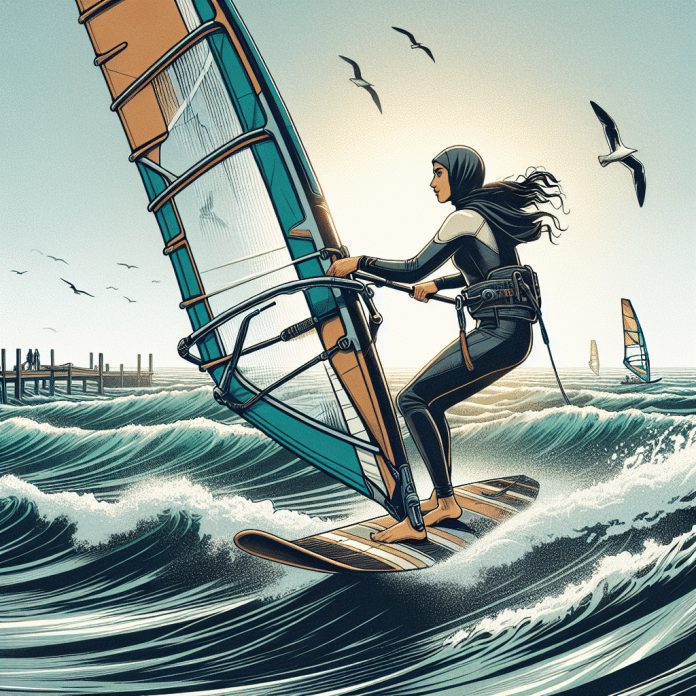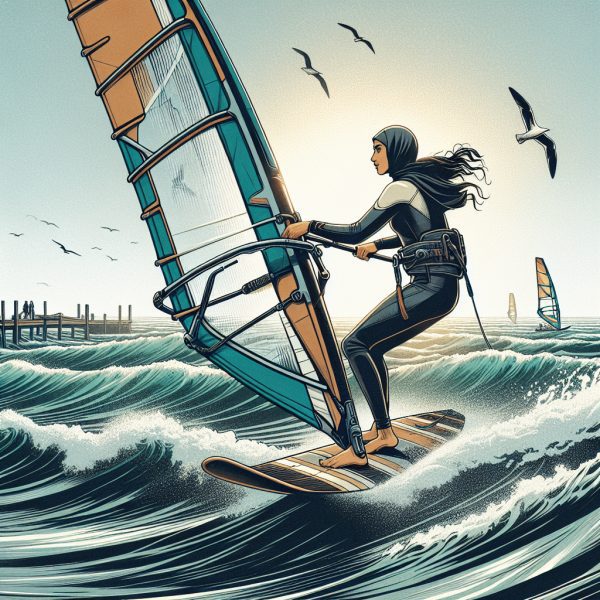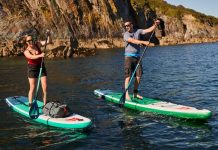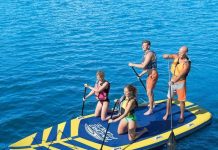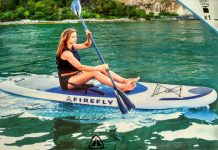Imagine gliding across crystal-clear waters, feeling the exhilarating rush of the wind in your hair, and effortlessly maneuvering through the waves. In our article, we will explore the exciting world of windsurfing, where we will take you through the essential equipment you need to get started and provide you with valuable techniques to master this thrilling water sport. Get ready to embark on a journey of adventure and discovery as we unlock the secrets of windsurfing and help you learn to ride the waves like a pro.
Choosing the Right Windsurfing Equipment
When it comes to windsurfing, choosing the right equipment is crucial for a successful and enjoyable experience on the water. Let’s break down the different components of windsurfing gear and understand their importance.
The Windsurfing Board
The windsurfing board is the foundation of your windsurfing setup. It provides stability, buoyancy, and maneuverability on the water. When selecting a board, consider your skill level, weight, and the type of conditions you’ll be windsurfing in. Beginners generally start with wider, more stable boards, while advanced riders may opt for narrower, more responsive designs.
The Sail
The sail is what catches the wind and propels you forward. It relates directly to the power and control you have while windsurfing. Sail size is determined by factors such as wind strength and rider weight. Lighter winds call for larger sails, while stronger winds require smaller ones. It’s essential to choose a sail that matches your skill level and the conditions you’ll be sailing in.
The Mast
The mast is the backbone of the sail. It gives the sail its shape and enables it to catch the wind efficiently. Masts come in varying lengths and flexibilities. As a beginner, a stiffer and shorter mast may be more suitable, while advanced riders often prefer a more flexible and longer mast, allowing for greater maneuverability.
The Boom
The boom is the horizontal bar that connects to the mast and provides the rider with control over the sail. It allows you to apply pressure and steer the board. When choosing a boom, consider its length and construction material. Longer booms are generally more suitable for larger sails, while shorter ones work well with smaller sails.
The Fin
The fin is the vertical blade located at the bottom of the board. It provides stability and helps the board maintain its course. Fins come in various shapes and sizes, influencing the board’s maneuverability and speed. Deeper and larger fins offer better upwind performance, while shallower and smaller fins enable tighter turns and more agility.
Essential Gear and Accessories
In addition to the core equipment, there are several essential gear and accessories that every windsurfer should have.
Wetsuit and Harness
A wetsuit is essential for maintaining body warmth and protection while windsurfing. It comes in different thicknesses, allowing you to choose the appropriate one for the water temperature. A harness is also important, as it distributes the sail’s pull across your body, reducing strain on your arms and improving your overall control.
Life Jacket and Helmet
Safety should always be a top priority when engaging in water sports. A life jacket is crucial for buoyancy and staying afloat in case of an emergency. A helmet is also recommended to protect your head from potential impacts, especially in rough conditions or when attempting advanced maneuvers.
Footstraps and Fins
Footstraps are adjustable straps on the board that secure your feet and provide additional control. It’s important to position them correctly for your riding style and foot size. Fins, as mentioned earlier, play a vital role in your windsurfing performance. Ensure that your fins are securely attached to the board and in good condition.
Repair Kit
Windsurfing equipment is bound to experience wear and tear over time. Having a repair kit handy can mean the difference between continuing your session or having to end it prematurely. A repair kit typically includes items such as adhesive patches, sail repair tape, and replacement fin screws. It’s always a good idea to inspect and maintain your gear regularly to prevent major damages.
Understanding Windsurfing Techniques
To become a proficient windsurfer, it’s crucial to understand and practice various windsurfing techniques. Here are some key techniques every windsurfer should master.
Basic Stance and Balance
The basic stance and balance involve positioning your feet correctly on the board, distributing your weight evenly, and maintaining a stable posture. Learning how to balance effectively will help you stay upright and in control.
Upwind Sailing
Upwind sailing refers to navigating against the wind. It involves using specific techniques, such as edging the board and sheeting in the sail, to generate enough power to sail upwind. Mastering upwind sailing will allow you to reach your desired destination, even when the wind is blowing from the opposite direction.
Tacking and Gybing
Tacking and gybing are turning maneuvers that allow you to change direction while windsurfing. Tacking involves turning the board into the wind, while gybing involves turning away from the wind. These maneuvers require proper body positioning, sail control, and weight shifting to execute smoothly.
Harness and Footstrap Techniques
Using a harness and footstraps can greatly enhance your windsurfing experience. Harness techniques involve using your body weight and the harness lines to support the sail’s pull, reducing strain on your arms. Footstrap techniques involve using the footstraps to improve control and leverage over the board and sail.
Getting Started with Windsurfing
Now that you have a better understanding of the equipment and techniques involved in windsurfing, let’s explore the steps to get started on the water.
Choosing the Right Location and Conditions
Before heading out, carefully consider the location and weather conditions. Beginners should choose calm, flat water with minimal currents and obstacles. Light to moderate winds (8-20 knots) is suitable for learning and practicing. Avoid strong winds and rough waters until you have more experience.
Setting up the Equipment
Start by assembling your windsurfing equipment on the shore. Begin with attaching the mast to the board, followed by connecting the boom and sail. Ensure that all parts are securely fastened and double-check for any damages or wear. Pay attention to the sail rigging, making sure it is properly tensioned and adjusted.
Launching the Board
With your equipment set up, head into the water with the board, holding onto the mast and sail. Once you’re at a suitable depth, position yourself on the board and step onto it. Be mindful of the fin and the sail’s position to prevent any collisions or accidents. Gradually paddle or walk your way further into the water until you have enough depth to start windsurfing.
Practicing the Basic Techniques
Now that you’re in the water, it’s time to put your newly acquired skills to practice. Start by finding your balance on the board and getting comfortable with the sail’s power. Practice tacking and gybing maneuvers, keeping in mind the correct body positioning and weight distribution. It’s normal to stumble and fall, but with perseverance, you’ll gradually improve your skills and gain confidence on the water.
Improving Your Windsurfing Skills
To take your windsurfing to the next level, consider focusing on specific areas of improvement and mastering advanced techniques.
Learning Advanced Maneuvers
Once you have a solid foundation, you can start learning advanced maneuvers such as planing, carving turns, jump jibes, and freestyle tricks. These maneuvers require precise control, coordination, and confidence. Practice in suitable conditions and gradually increase the difficulty level as you progress.
Mastering Planing and Speed
Planing refers to reaching a speed where the board is lifted out of the water, resulting in a thrilling and exhilarating experience. To achieve planing, you need to harness the wind’s power and adjust your technique accordingly. Focus on maximizing sail power, adjusting foot pressure, and adopting a more dynamic stance to achieve higher speeds.
Navigating Challenging Conditions
As you gain experience, you’ll inevitably encounter more challenging conditions, such as strong winds, waves, and currents. Embrace these opportunities as they allow you to develop adaptability and improve your overall sailing skills. Learning how to handle high winds, surf waves, and counteract currents will make you a well-rounded windsurfer.
Using Waves and Swells
Once you’ve mastered the basics, exploring waves and swells can take your windsurfing to a whole new level. Learning wave riding techniques involves reading the waves, timing your maneuvers, and incorporating jumps and tricks into your rides. Seek out appropriate wave conditions, practice wave selection, and gradually progress in wave height and complexity.
Safety Guidelines for Windsurfing
Windsurfing is an adventurous and thrilling sport, but safety should always be a priority. Here are some essential safety guidelines to follow:
Checking the Weather Conditions
Before heading out, check the weather forecast and wind conditions. Be aware of any severe weather warnings and avoid windsurfing during storms or when thunderstorms are predicted. Keep an eye on wind speed and direction to ensure they are suitable for your skill level.
Using Proper Safety Equipment
Always wear a life jacket and a helmet while windsurfing. They are essential for your safety and protection. Additionally, consider using a personal floatation device (PFD) and impact vest for extra buoyancy and impact resistance.
Avoiding Hazardous Areas
Stay away from areas with strong currents, dangerous rock formations, or submerged objects. Observe any marked swim zones, shipping lanes, and boating areas. Familiarize yourself with the local regulations and adhere to them for your safety and the safety of others.
Knowing When to Stop
Pay attention to your energy levels, weather conditions, and any signs of fatigue. If you’re feeling exhausted or facing challenging conditions, it’s better to call it a day. Pushing yourself beyond your limits can lead to accidents and injuries. Listen to your body and use your judgment to determine when it’s time to stop for the day.
Common Mistakes and How to Avoid Them
Even experienced windsurfers can make mistakes that hinder their progress and enjoyment. Here are some common mistakes to avoid:
Failing to Properly Rig the Sail
Properly rigging the sail is essential for maximizing its performance and control. Ensure that the sail is correctly tensioned, the battens are properly inserted, and the downhaul and outhaul settings are adjusted according to wind conditions. Neglecting these rigging aspects can lead to poor sail control and restricted maneuverability.
Not Balancing Your Weight Correctly
Weight distribution plays a crucial role in windsurfing. Failing to distribute your weight correctly can result in instability, loss of control, and even falls. Practice finding the right balance between your feet, leaning into the wind, and shifting your weight when necessary to maintain stability and control.
Overpowering the Sail
In strong wind conditions, it’s common for beginners to feel overwhelmed by the power of the sail. Overpowering the sail can lead to loss of control and potentially dangerous situations. Gradually increase your sail size and wind strength as you progress, giving yourself time to adapt to the extra power and maintain control.
Ignoring the Wind Changes
Wind conditions can change unexpectedly, requiring you to adjust your technique and sail handling. Ignoring these changes or failing to respond appropriately can result in loss of control or being caught off guard by sudden gusts or lulls. Continuously monitor the wind conditions and make the necessary adjustments to ensure a safe and enjoyable ride.
Maintaining and Repairing Your Windsurfing Equipment
Taking care of your windsurfing equipment is essential to prolong its lifespan and maintain its performance. Here are some maintenance and repair tips:
Cleaning and Storage Tips
After each session, thoroughly rinse your equipment with freshwater to remove saltwater and sand, which can damage the gear over time. Store your equipment in a cool, dry place away from direct sunlight. Consider using protective covers for your board, sail, and mast to prevent unnecessary wear and tear.
Replacing Worn-out Parts
Regularly inspect your equipment, paying close attention to areas that experience high stress, such as mast bases, footstraps, and harness lines. If any parts show signs of wear or damage, replace them promptly to ensure optimal performance and avoid potential accidents.
Repairing Minor Damages
Minor damages, such as small tears, punctures, or chipped fins, can typically be repaired with a repair kit. Follow the instructions provided with the repair kit to fix these minor damages promptly. If you’re unsure or the damage is more severe, it’s recommended to seek professional repair services.
Finding Professional Repair Services
For major damages or repairs that are beyond your expertise, it’s best to consult a professional repair service. They have the necessary tools, experience, and knowledge to fix complex issues, ensuring your equipment is safe and ready for your next windsurfing adventure.
Benefits of Windsurfing
Windsurfing offers numerous benefits that go beyond just the thrill of riding the waves. Here are some advantages of engaging in this exhilarating sport:
Improving Fitness and Stamina
Windsurfing is a highly physical activity that engages multiple muscle groups, including the arms, legs, core, and back. It provides an excellent cardiovascular workout and helps improve strength, endurance, and overall fitness levels. Regular windsurfing sessions can contribute to weight loss and toning of the muscles.
Stress Relief and Mental Well-being
Being out on the water, surrounded by nature, and enjoying the thrill of windsurfing can have a profoundly positive effect on mental well-being. The combination of fresh air, the sounds of nature, and the dopamine release from physical activity can reduce stress, elevate mood, and promote relaxation.
Connecting with Nature
Windsurfing allows you to connect with nature on a deeper level. As you glide across the water, you can observe marine life, enjoy stunning sunsets, and feel a sense of harmony with the elements. This connection with nature can lead to a greater appreciation for the environment and a desire to protect it.
Socializing and Building Relationships
Windsurfing provides an opportunity to meet like-minded individuals who share a passion for the sport. Joining a windsurfing community or participating in local events and competitions allows you to connect with fellow windsurfers, exchange experiences, and build lasting friendships. Having a network of supportive individuals can enhance your windsurfing journey and add an extra layer of enjoyment to your outings.
Joining a Windsurfing Community
To fully immerse yourself in the world of windsurfing, consider joining a windsurfing community. Here’s how you can get involved:
Finding Local Windsurfing Clubs
Research local windsurfing clubs or organizations in your area. These clubs often offer membership benefits, organized training sessions, equipment rental, and access to exclusive spots. Joining a club allows you to connect with experienced windsurfers and become part of a supportive community.
Attending Windsurfing Events and Competitions
Keep an eye out for local and regional windsurfing events and competitions. Attending these events provides an opportunity to spectate, learn from experienced windsurfers, and immerse yourself in the vibrant windsurfing culture. Some events also offer beginner-friendly clinics and workshops to help you refine your skills.
Learning from Experienced Windsurfers
Experienced windsurfers have a wealth of knowledge and expertise to share. Don’t hesitate to approach and engage with them at your local windsurfing spot or events. They can offer valuable tips, guidance, and insights that can help you progress and overcome any challenges you may face.
Sharing Your Progress and Experiences
As you embark on your windsurfing journey, document your progress and share your experiences. Join online forums, social media groups, or start your own blog or vlog to connect with other windsurfers worldwide. Sharing your adventures allows you to inspire others, seek advice, and celebrate your accomplishments within the windsurfing community.
Windsurfing is a thrilling and rewarding sport that combines physical activity, mental stimulation, and a deep connection with nature. By choosing the right equipment, practicing various techniques, and prioritizing safety, you can embark on an exciting windsurfing journey that will bring you joy, fitness, and lifelong memories. So grab your board, hoist your sail, and let the wind carry you to new horizons in the captivating world of windsurfing!

